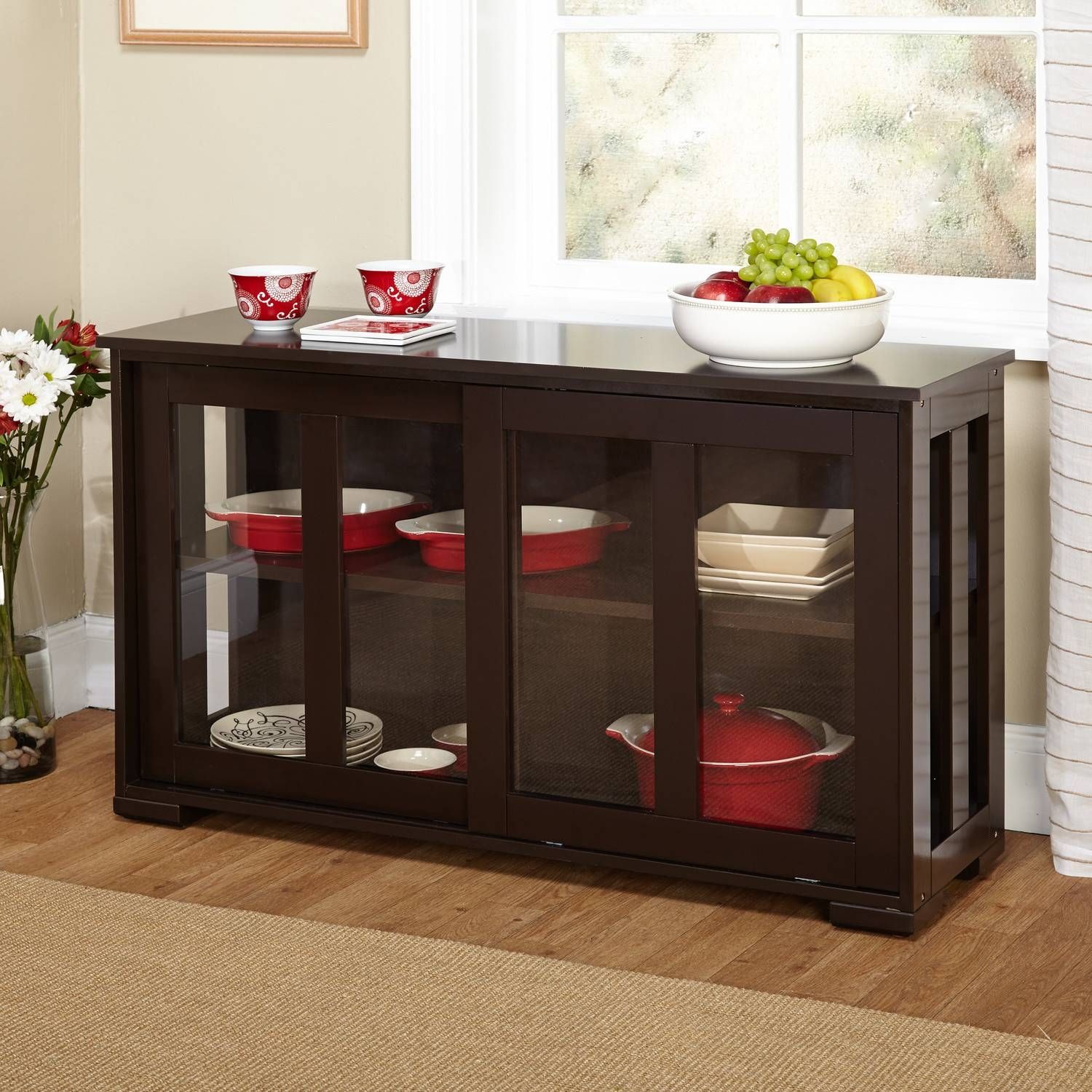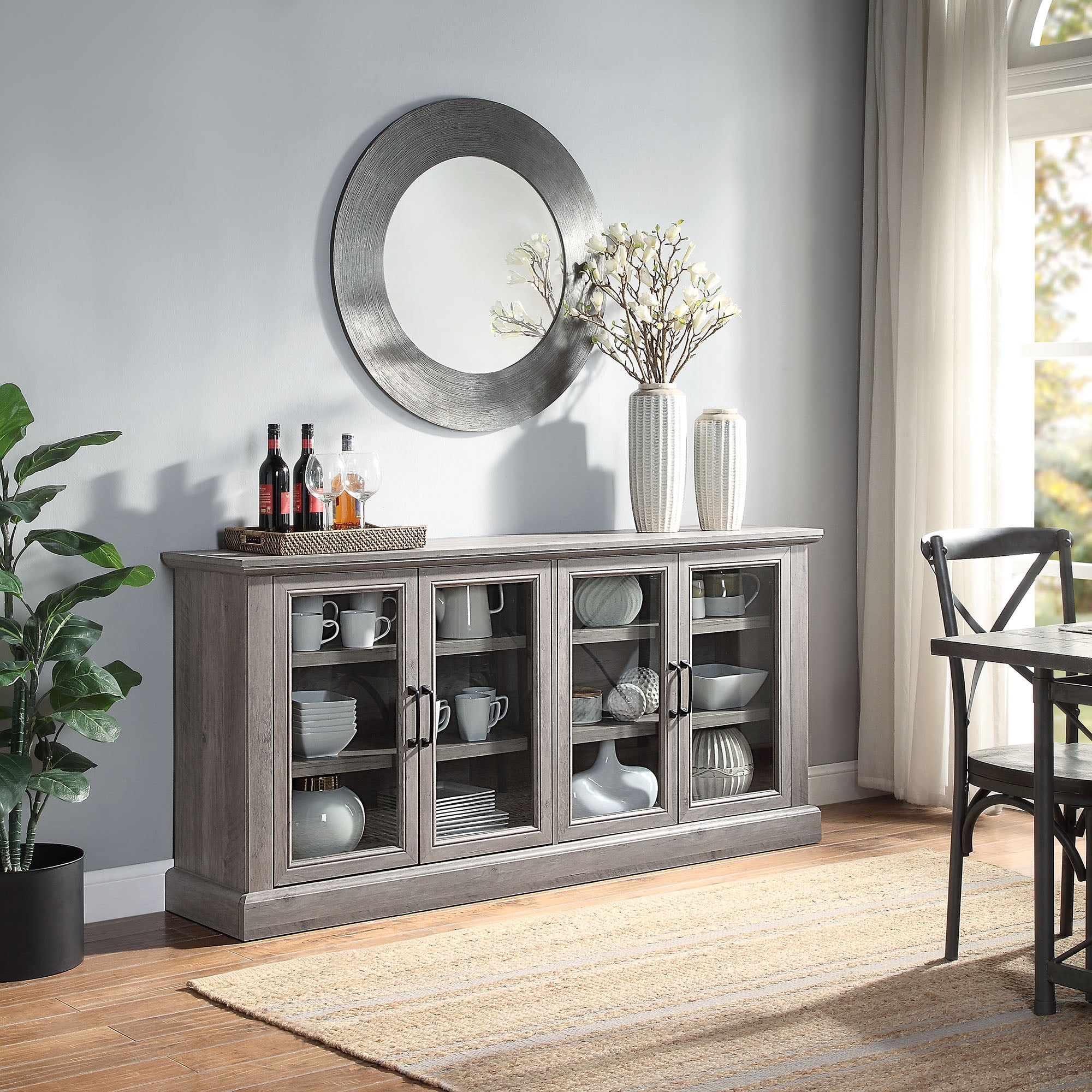Functionality & Practical Considerations

Sideboard cabinets with glass doors offer a blend of style and practicality, but their effectiveness hinges on careful consideration of design and placement. The choice of a sideboard with glass doors impacts not only the aesthetics of a room but also its functionality and the longevity of stored items. Understanding these aspects is crucial for making an informed purchase.
The functionality of a sideboard cabinet with glass doors is directly tied to its storage options and the impact of the glass doors themselves. A well-designed piece should offer ample storage while also showcasing its contents attractively. Poor design choices, however, can lead to dust accumulation, light damage, and ultimately, a less functional piece of furniture.
Storage Options in Sideboard Cabinets with Glass Doors
Various designs offer a range of storage solutions. The versatility of these options allows for adaptation to diverse storage needs and preferences. Careful consideration of these options will ensure the cabinet optimally meets individual requirements.
- Adjustable Shelves: These allow for customization of shelf height to accommodate items of varying sizes, maximizing vertical space and optimizing storage capacity. This is particularly beneficial for storing items of different heights, such as glassware, books, or decorative objects.
- Fixed Shelves: While less flexible than adjustable shelves, fixed shelves provide a sturdy and reliable platform for heavier items. They are ideal for creating designated storage areas for specific items, promoting organization and preventing items from shifting.
- Drawers: Drawers offer concealed storage for items that are less visually appealing or need protection from dust and light. They are particularly useful for storing silverware, linens, or other smaller items.
- Pull-out Shelves: These shelves slide out completely, providing easy access to items stored at the back of the cabinet. This is especially convenient for larger or heavier items that might be difficult to reach otherwise.
- Wine Racks: Some sideboard cabinets incorporate dedicated wine racks, offering convenient and stylish storage for wine bottles. This is a specialized feature ideal for homes with a wine collection.
Pros and Cons of Glass Doors for Storage
The use of glass doors presents both advantages and disadvantages that should be carefully weighed before purchasing a sideboard cabinet. Understanding these trade-offs is vital for making an informed decision that aligns with one’s needs and preferences.
- Pros: Glass doors allow for showcasing attractive items, creating a visually appealing display. They can add a sense of elegance and sophistication to a room. They also allow for easy identification of stored items without opening the cabinet.
- Cons: Glass doors are more susceptible to dust accumulation, requiring more frequent cleaning. Items stored behind glass doors may be exposed to damaging UV light, potentially fading colors or damaging delicate materials. The glass itself can be fragile and prone to breakage.
Sample Room Layout Incorporating a Sideboard Cabinet
The strategic placement of a sideboard cabinet can significantly enhance a room’s functionality and aesthetics. The following table offers suggestions for various room types.
| Room Type | Suggested Placement | Purpose |
|---|---|---|
| Dining Room | Against a wall adjacent to the dining table | Storage for tableware, linens, and serving dishes |
| Living Room | Beneath a window or against a prominent wall | Display of decorative items, books, and media |
| Entryway | Near the entrance | Storage for keys, mail, and other everyday items |
Innovative Storage Solutions Integrated into Sideboard Cabinets
Modern sideboard designs often incorporate innovative storage solutions to enhance functionality and convenience. These features can significantly improve the usability and organization capabilities of the cabinet.
- Internal Lighting: Integrated LED lighting illuminates the contents of the cabinet, making items easier to see and enhancing the visual appeal of displayed items. This is particularly useful for showcasing collectibles or china.
- Hidden Compartments: Some designs include hidden compartments or drawers, providing discreet storage for items that need to be kept out of sight. These can be used for storing remotes, paperwork, or other items that might clutter a surface.
- Spice Racks (for kitchen sideboards): Integrated spice racks within a kitchen sideboard cabinet offer efficient and organized storage for spices, keeping them readily accessible and within easy reach during cooking.
Materials & Construction: Sideboard Cabinet With Glass Doors

Choosing the right materials for your sideboard cabinet with glass doors significantly impacts its longevity, aesthetic appeal, and overall cost. The selection process should carefully weigh durability, maintenance requirements, and budget constraints against the desired style and intended use of the piece.
The following table compares common materials used in sideboard construction.
Material Comparison
| Material | Durability | Maintenance | Cost |
|---|---|---|---|
| Solid Wood (e.g., oak, cherry, mahogany) | High; resistant to damage with proper care. Can last for generations. | Moderate; requires regular polishing and occasional refinishing. Susceptible to scratches and water damage. | High; varies greatly depending on wood type and quality. |
| Metal (e.g., steel, aluminum) | High; resistant to scratches and dents, but can rust or corrode. | Low; typically requires only occasional cleaning. | Moderate to High; varies depending on the metal type and finish. |
| Composite Materials (e.g., MDF, particleboard) | Moderate; susceptible to damage from moisture and heavy impacts. | Low; usually requires only wiping clean. | Low to Moderate; generally the most affordable option. |
| Glass | Moderate to High; depends on the type of glass (tempered glass is more durable). Susceptible to shattering. | Low; easily cleaned with glass cleaner. | Moderate; varies depending on the type and thickness. |
Material Selection Factors
Style, budget, and intended use are critical factors influencing material selection. A traditional setting might favor the warmth and elegance of solid wood, while a modern space could benefit from the clean lines of metal or the sleek look of high-gloss composite materials. Budget limitations might necessitate the use of more affordable composites, while a desire for exceptional durability might justify the higher cost of solid wood or high-quality metal. The intended use—whether for storing delicate china or everyday items—will also inform the choice of materials. For example, a sideboard intended for a high-traffic area might benefit from the resilience of metal over the more delicate nature of wood.
Door Attachment and Hinge Installation, Sideboard cabinet with glass doors
The process of assembling a simple sideboard cabinet and attaching the glass doors involves several key steps. Proper execution ensures a secure and aesthetically pleasing final product.
1. Prepare the cabinet frame. Ensure the frame is level and stable.
2. Position the hinges on the cabinet doors. Mark the hinge placement points on the door and the cabinet frame.
3. Attach the hinges to the doors using appropriate screws. Ensure the hinges are aligned correctly.
4. Carefully position the doors on the cabinet frame. Align the hinges with the corresponding hinge plates on the frame.
5. Attach the hinge plates to the cabinet frame using screws. Tighten securely but avoid over-tightening.
6. Check the door alignment and adjust as needed. Ensure the doors open and close smoothly.
7. Secure any additional hardware such as door handles or latches.
8. Inspect the completed assembly for any imperfections or loose connections.
